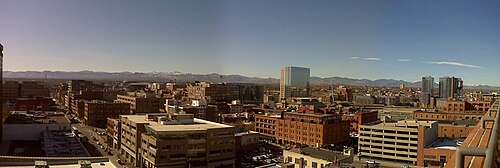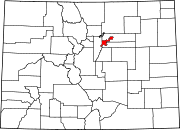
Denver is a consolidated city and county, the capital, and most populous city of the U.S. state of Colorado. Its population was 715,522 at the 2020 census, a 19.22% increase since 2010. It is the 19th-most populous city in the United States and the fifth most populous state capital. It is the principal city of the Denver–Aurora–Lakewood metropolitan statistical area, the most populous metropolitan statistical area in Colorado and the first city of the Front Range Urban Corridor.

The Territory of Colorado was an organized incorporated territory of the United States that existed from February 28, 1861, until August 1, 1876, when it was admitted to the Union as the State of Colorado.

Confluence Park is an urban park encompassing the confluence of Cherry Creek and the South Platte River in Denver's Lower Downtown (LoDo), a bustling district of 19th-century brick warehouses and storefronts that has been redeveloped since the late 1980s.

Tattered Cover is a bookstore chain in Denver, Colorado. It is one of the largest independent bookstores in the United States. Tattered Cover is open seven days a week at all branches, hosts prominent book signings, and is known for its customer service. Together, the stores maintain an inventory of over half a million books. Its LoDo store houses an events space that can seat over 250 persons, while its East Colfax store can seat around 100.

Auraria was a small mining settlement in the Kansas Territory in the United States. Today it survives in its original location as a neighborhood of Denver, Colorado, south of the confluence of Cherry Creek and the South Platte River.
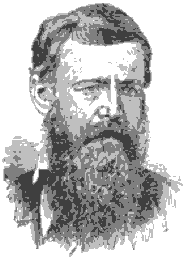
William Larimer Jr. was an American businessman, investor, militia general, and politician who is best known as the founder of Denver, Colorado, in 1858. Larimer often went by "General Larimer", having acquired the title in the Pennsylvania Militia.

Denver Union Station is the main railway station and central transportation hub in Denver, Colorado. It is located at 17th and Wynkoop Streets in the present-day LoDo district and includes the historic station house, a modern open-air train shed, a 22-gate underground bus station, and light rail station. A station was first opened on the site on June 1, 1881, but burned down in 1894. The current structure was erected in two stages, with an enlarged central portion completed in 1914.

Cherry Creek is a neighborhood in Denver, Colorado, in the United States. It has many newer residences mixed in with some of Denver's older homes.
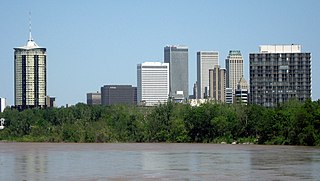
Tulsa is the second-largest city in the state of Oklahoma. It has many diverse neighborhoods due to its size.
The History of Denver details the history of the City and County of Denver, Colorado, the United States from its founding in 1858 to modern-day. Ever since the gold rush, Denver has been Colorado’s gateway and major metropolis. With its location at the intersection of the plains and the mountains, its people and institutions have tied together the sections of the state and served as a point of contact between Colorado and the wider world. As the state’s political capital and largest city, Denver has been the natural center for decision-making. New programs and ideas have typically spread outward through the public agencies and private organizations that have Denver headquarters.

Highland is a distinct city-center neighborhood in Denver, Colorado, United States, bounded by West 38th Avenue to the north, a Union Pacific Railroad line on the east, the South Platte River to the southeast, Speer Boulevard on the south, and Federal Boulevard on the west. The Highlands is sometimes used to refer to two separate city-center neighborhoods in Denver; Highland and West Highland, although the two neighborhoods are distinct. Highland and West Highland are both in the area that is referred to as the Northside. Highland is located immediately northwest of downtown. Note that the Highland neighborhood association has a slightly different definition with the easternmost boundary stopping at I-25. And the West Highland neighborhood to the immediate west of Highland, with the borders of 38th and 29th Avenues on the north and south and Federal and Sheridan Boulevards on the east and west. To distinguish between its immediately adjacent neighbor, West Highland, Highland is sometimes referred to as East Highland, Lower Highland or LoHi. The two together are casually called "the Highlands," a term which often falsely encompasses other Northwest Denver neighborhoods such as Jefferson Park, Sunnyside and Berkeley. Realtors have particularly pushed the inclusion of the recently gentrified Berkeley, located directly north of West Highland, as part of the Highlands, sometimes going so far as to refer to Berkeley and parts of Sunnyside as the "Upper Highlands". To add further confusion, within the Highlands neighborhoods there are several historic designations of various degrees, including Potter Highlands, Scottish Highlands and Highlands Park.

Baker is a neighborhood in Denver, Colorado, United States.
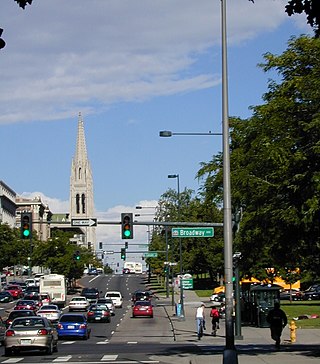
The oldest part of Denver, Colorado, now the neighborhoods of Auraria Campus, LoDo, much of downtown, and Five Points, is laid out on a grid plan that is oriented diagonal to the four cardinal directions. The rest of the city, including the eastern part of downtown, is laid out primarily on a grid oriented to the cardinal directions. In this larger grid, from east to west, there are generally 16 city blocks per mile, except between Zuni Street and Lowell Boulevard in west Denver. From north to south, there are typically eight blocks per mile, although there are many areas with more blocks per mile. Addresses follow a decimal system, with addresses advancing by one hundred at each cross street.

Downtown Denver is the main financial, commercial, business, and entertainment district in Denver, Colorado, United States. There is over 23 million square feet (2,100,000 m2) of office space in downtown Denver, with 132,000 workers. The downtown area consists mostly of the neighborhoods of Union Station and Central Business District. LoDo and RiNo are notable districts within downtown. Some of the more popular specific attractions include the 16th Street pedestrian mall, Larimer Square, the re-emerging Theatre District near Curtis and 14th, and Civic Center Park. Surrounding neighborhoods include Capitol Hill and Uptown to the east, Highland to the west, Five Points to the north, and the Golden Triangle to the south.

Lincoln Park is a neighborhood and public park close to downtown Denver, Colorado and the location of the Art District on Santa Fe. The neighborhood is one of Denver's oldest and is just to the south of the area where Denver was first settled in the 1850s. Many houses date from about 1900. The neighborhood is sometimes called "La Alma/Lincoln Park" or the West Side.

Union Station is a downtown neighborhood of Denver, Colorado. In 2020, the population of the neighborhood was roughly 5,878.
Dana Hudkins Crawford is an American architectural conservation developer and preservationist working in Denver, Colorado. She has been involved in almost every renovation project in downtown Denver, from the initial designation of the LoDo District and creation of Larimer Square to the Union Station. She was recognized by her alma mater, Radcliffe College, for the Larimer Square project, was inducted into the Colorado Women's Hall of Fame, and in 2013 the hotel at the restoration project of Union Station was renamed as the Crawford Hotel in honor of her contributions to preserve the history of Denver.

Union Station North, formerly known as Prospect, is a neighborhood within the city limits of Denver, Colorado. Previously dominated by industrial buildings, waste, railroad tracks and considered an area of the city to be avoided, today it has been rehabilitated into multi-story residential buildings, restaurants, amenities, easy access to downtown Denver, and is a short walk to the South Platte River Trail, which runs along its northern boundary.




